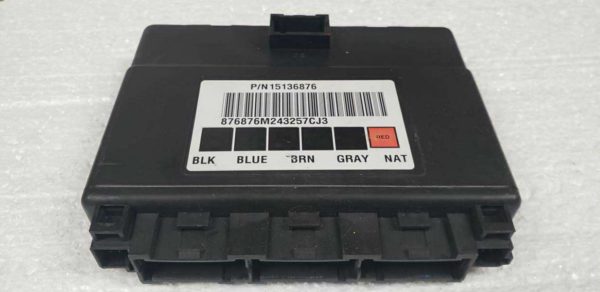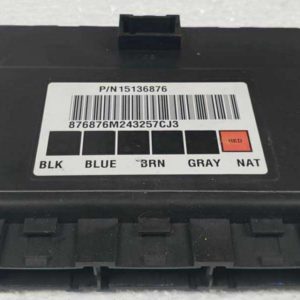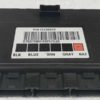Tired of Electrical Gremlins in Your GM Truck or Van?
If you’re dealing with flickering lights, malfunctioning power windows and locks, a security light that won’t turn off, or even a no-start condition, the culprit is often a failing Body Control Module (BCM). As the central hub for your vehicle’s body electronics, a faulty BCM can cause a cascade of frustrating and seemingly unrelated issues. This isn’t just an annoyance; it affects your vehicle’s daily usability and security. For over 20 years, I’ve seen these exact problems in my shop, and I know how critical a reliable BCM is to getting your truck or van back to 100%.
From the Diagnostic Bay: A 2006 Silverado’s Ghost
Just last month, a 2006 Silverado 2500 was towed in. The owner was at his wit’s end. The radio would turn on by itself, the driver’s side power window worked intermittently, and the horn would randomly honk. He’d already replaced the battery and checked all the fuses. After connecting my scan tool, I saw multiple communication loss codes with various modules. This pointed directly to the BCM. The internal logic was failing, sending erratic signals throughout the truck. We replaced it with a VIN-programmed unit just like this one, and it was like an exorcism—all the electrical ghosts vanished instantly. This is a classic failure pattern for these vehicles.
The Simple, Reliable Solution: VIN-Programmed and Ready to Go
Forget expensive dealership visits and programming fees. We take the hassle out of the repair. Simply provide your vehicle’s VIN during checkout, and our technicians will program this 2003-2007 GM BCM with the latest GM software specific to your truck or van. It arrives at your door ready for installation, ensuring all factory options your vehicle came with work correctly from the start. This is the most efficient way to restore your vehicle’s functionality and peace of mind.
Is Your GM Truck or Van Showing These Signs?
- ✔ Erratic or non-working power windows, door locks, or mirrors.
- ✔ Interior or exterior lights flickering, staying on, or not working at all.
- ✔ The security or anti-theft system light is on, preventing the engine from starting.
- ✔ Instrument cluster gauges behaving erratically or going dead.
- ✔ The radio or climate controls are malfunctioning.
- ✔ False warnings on the driver information center (DIC).
- ✔ Communication errors when using a diagnostic scan tool.
A Straightforward Guide to Your BCM Installation
Replacing the BCM is a manageable job for a DIYer with basic tools. While the location varies slightly between trucks (under the steering column) and vans (center dash), the process is similar.
- Safety First: Always disconnect the negative terminal from your vehicle’s battery and wait a few minutes before starting work.
- Locate the BCM: On Silverado and Sierra pickups, it’s typically located under the driver’s side dashboard, near the steering column. On Express and Savana vans, it’s usually behind the center dash trim.
- Remove Connectors: Carefully unplug all electrical connectors from the old BCM. They have locking tabs, so be gentle to avoid breaking them. Note their orientation.
- Swap the Module: Unbolt or unclip the old BCM and remove it. Install the new, pre-programmed BCM in its place.
- Reconnect Everything: Plug all the electrical connectors firmly into the new module. Reconnect the negative battery terminal.
- Post-Installation Procedures: After installation, two critical steps are required. First, the ‘Setup SDM Primary Key in BCM’ procedure must be performed with a capable scan tool to clear the airbag light. Second, some vehicles may need a brake pedal position sensor recalibration. If you are not equipped to do this, a local repair shop can perform these final steps for you.
Verified Fitment For Your GM Vehicle
This BCM is a direct replacement for multiple part numbers, including 15167329, 15194169, 15747545, 15136224, 15116065, 15198115, 15136876, and 10367689. It is compatible with the following models and options:
2003: Body Control (BCM); (center dash)
2004-2007: Body Control (BCM); (center dash), w/o commercial tradesman package
Chevrolet Silverado / GMC Sierra Pickups (1500/2500/3500):
2003-2005: Body Control (BCM); (under steering column), exc. Crew Cab
2006: Body Control (BCM); (under steering column), AT or MT, exc. Crew Cab
2007 Classic: Body Control (BCM); classic style (creased door skin), (under steering column), AT or MT, exc. Crew Cab
Chevrolet SSR:
2003-2006: Body Control (BCM)
Note: Please verify your specific options (e.g., transmission, cab type) against the detailed list. If you’re unsure, contact us with your VIN.
Frequently Asked Questions
Do I really need to provide my VIN?
Yes, absolutely. Providing your VIN is critical. We use it to load the correct GM software and settings for your vehicle’s specific options. This ensures a seamless installation without the need for dealer programming.
What functions does the BCM control?
The Body Control Module acts as the brain for most of your vehicle’s non-engine related electronics. This includes power windows, power locks, interior and exterior lighting, the security system, instrument cluster warnings, and sometimes even the radio and climate controls.
Is this a repair I can do myself?
For many DIY enthusiasts, yes. The physical replacement is straightforward with basic hand tools. However, the final steps require a bi-directional scan tool to reset the airbag system and potentially recalibrate the brake pedal sensor. If you don’t have this tool, you will need assistance from a professional mechanic to complete the job safely.
Will this fix my ‘Service Airbag’ light?
After installation, the airbag light will be on. This is normal. You MUST perform the ‘Setup SDM Primary Key in BCM’ procedure with a diagnostic tool. This re-establishes communication between the new BCM and the airbag system (SDM), which will then turn off the light, ensuring the system is active.
Why is my brake pedal feel different or the light on?
On some models, the BCM is tied into the brake pedal position sensor data. After replacement, a recalibration might be necessary to ensure the system recognizes the correct pedal position for proper brake light operation and stability control function. This is also done with a professional scan tool.


